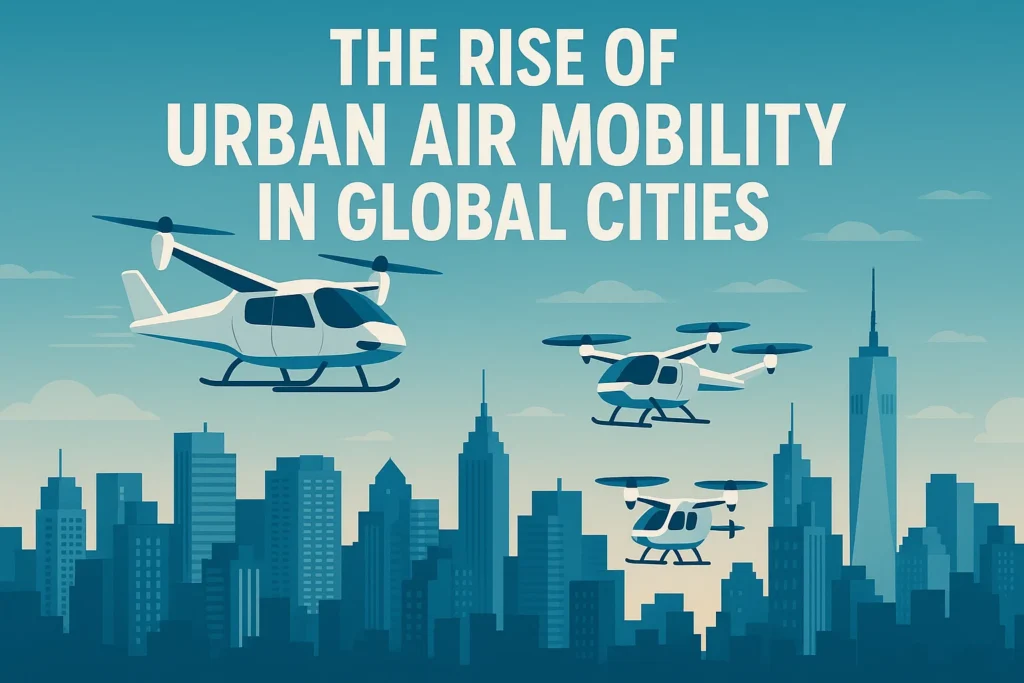🌍 Introduction: From Ground Traffic to Sky Transit
As cities grow denser and road congestion worsens, a new form of transport is taking off — literally. Urban Air Mobility (UAM) is the concept of using helicopters, drones, and eVTOL aircraft to move people and cargo through the sky, cutting travel time and reducing emissions.
At DreamSafar.in, we explore the global rise of Urban Air Mobility, the cities leading the change, and what the future holds for aerial commutes.
🚁 What Is Urban Air Mobility (UAM)?
Urban Air Mobility refers to short-distance air transport within urban areas, using aircraft such as:
-
🚁 eVTOLs (electric Vertical Take-Off and Landing aircraft)
-
🚁 Passenger drones
-
🚁 Helicopter air taxis
UAM aims to ease ground congestion, reduce carbon emissions, and revolutionize city transport with on-demand flying services.
🌆 Leading Cities in Urban Air Mobility
| City | UAM Development Highlights |
|---|---|
| Dubai | Trials of air taxis with Volocopter; helipad-ready infrastructure |
| Los Angeles | Partnered with Archer Aviation for electric air taxis by 2028 |
| Seoul | Government-backed UAM roadmap; SK Telecom collaboration |
| Paris | Preparing UAM infrastructure for 2024 Olympics |
| Mumbai | DGCA-approved helicopter corridors in development |
| Singapore | Skyports developing vertiports with global eVTOL players |
⚙️ Aircraft Powering the UAM Revolution
| Aircraft Model | Type | Manufacturer | Notable Feature |
|---|---|---|---|
| Volocopter 2X | eVTOL | Volocopter (Germany) | Fully electric, short city hops |
| Joby S4 | eVTOL | Joby Aviation (USA) | 240 km range, low noise |
| EHang 216 | Passenger drone | EHang (China) | Fully autonomous, 2-seater |
| CityAirbus NextGen | eVTOL | Airbus (EU) | 4 seats, zero emissions |
| Bell Nexus | Hybrid VTOL | Bell (USA) | Tilt-rotor, high-speed flight |
🛠️ UAM Infrastructure Requirements
-
Vertiports for takeoff and landing
-
Air traffic management (ATM) systems
-
Charging and battery swap stations
-
Regulatory frameworks for flight safety and air corridors
-
Noise and privacy standards for dense urban areas
📍 Companies like Skyports, UrbanV, and SkyDrive are building smart UAM-ready hubs.
🌐 Benefits of Urban Air Mobility
✅ Reduced Travel Time
Cut 60-minute road commutes to under 10 minutes by air.
✅ Eco-Friendly Transport
Most eVTOLs are electric, reducing city carbon footprints.
✅ Smart City Integration
UAM links with metro, rail, and app-based ride platforms.
✅ Emergency Response Boost
Faster movement of medical staff, organs, and supplies.
⚠️ Challenges Ahead
-
Airspace congestion in urban skies
-
Public trust and acceptance
-
Pilot training or autonomous tech development
-
Battery range and safety concerns
-
Cost of infrastructure vs affordability
🚧 In India, concerns over regulatory gaps, affordability, and safety must be addressed for UAM to take off at scale.
🔗 Useful Links – DreamSafar.in
🌐 External Resources
❓ FAQ: Urban Air Mobility
❓ What is the difference between UAM and traditional helicopters?
UAM uses smaller, electric or hybrid aircraft, designed for short intra-city travel, often autonomously, with lower noise and emissions.
❓ Is UAM already operational anywhere?
Yes — cities like Dubai, Guangzhou, and Seoul are conducting active UAM trials.
❓ Will India adopt Urban Air Mobility soon?
India is testing UAM potential in Mumbai, Bangalore, and Delhi, but full rollout depends on infrastructure, cost, and regulatory readiness.
❓ Are UAM flights safe?
eVTOLs undergo extensive testing and certification. Many include redundant motors, parachutes, and AI-guided control systems.
🏁 Final Thoughts
Urban Air Mobility is no longer science fiction. It’s a quiet, electric revolution in the skies above global cities. As infrastructure matures and technology advances, aerial commuting may become as common as cab rides in the next decade.
Stay ahead of the curve with DreamSafar.in — your guide to the future of helicopter travel, UAM, and air innovation.


